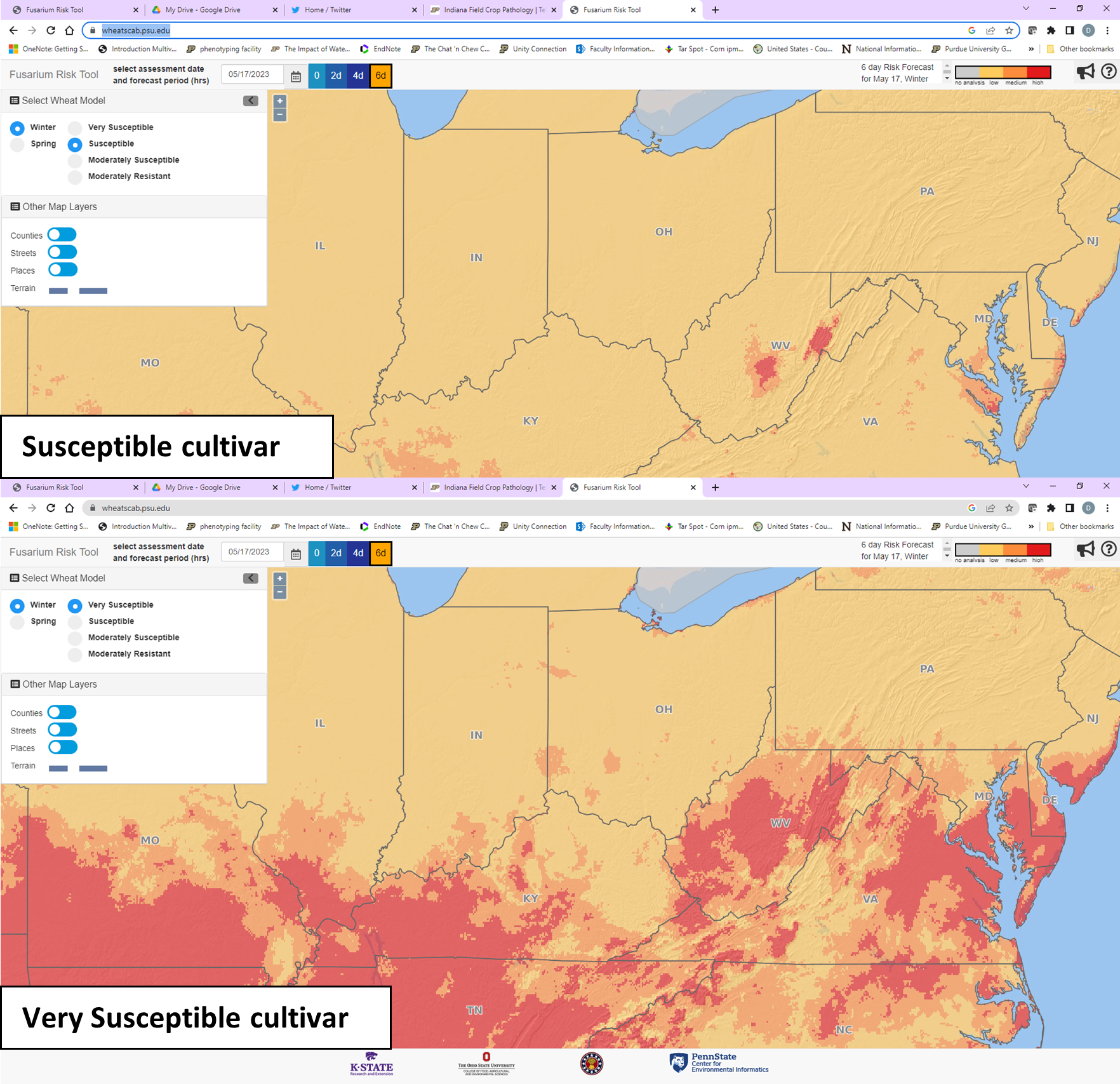Wheat is starting to head out across the central and northern Indiana, with flowering not too far behind. Our plots in southern Indiana hit early anthesis (flowering) last week. Rainy, wet conditions can favor many fungal diseases in wheat. Our southern neighbors have started reporting multiple diseases in wheat. These include – strip and leaf rust. We did find Septoria leaf spot in the lower canopy in our southwest plots.
There are a number of resources are available to help distinguish wheat leaf diseases, they include the Purdue Wheat Field Guide (https://www.edustore.purdue.edu/item.asp?Item_Number=ID-448) and “Identifying Rust Diseases of Wheat and Barley.” https://www.ars.usda.gov/ARSUserFiles/50620500/Cerealrusts/Rust_Diseases_National.pdf
Samples can always be submitted to the Purdue Plant Pest Diagnostic Lab for disease identification and confirmation. https://ag.purdue.edu/btny/ppdl/Pages/default.aspx
During flowering (anthesis) warm, wet weather with high relative humidity will favor the development of Fusarium head blight (scab). Fusarium head blight (FHB) is caused by the fungus Fusarium graminearium. It infects wheat during flowering, beginning at Feekes 10.5.1. Symptoms of FHB will appear as bleached spiklets on the head later in the season. Infection can lead to small or shriveled grain kernels referred to as “tombstones.” In addition to shriveled grain, this fungus can produce mycotoxins such as deoxynivalenol (DON), which can accumulated in the infected grain.

Figure 1. Wheat beginning to flower and Fusarium head blight infection. (Photo Credits: Darcy Telenko)
A number of resources are available to help you make disease management decisions in wheat.
1) The Fusarium Risk Assessment Tool is available at the following website. http://www.wheatscab.psu.edu/. This tool estimates the risk of a Fusarium head blight epidemic (> than 10% field severity) using weather conditions (temperature, rainfall, and relative humidity) measured 15 days prior to flowering. See below for the current risk map – all of Indiana is colored yellow (low risk for scab development), even if we select a very susceptible cultivar the risk still remains low for most of the state except the southern edge. You can see the risk increase in neighboring states where orange and red = medium to high risk of head blight due to favorable environmental conditions.
Keep in mind that actual disease risk depends heavily on the growth stage of wheat in your area. We are approaching a critical time here in Indiana and the good news it the risk still remains low; the estimate is most relevant just prior to flowering (Feekes 10.5.1) or the early stages of grain development. Fusarium head blight risk is highest when there are three or more days with extended periods of high relative humidity and moderate temperatures (65 to 80°F) during the early stages of kernel development.
Figure 2. Fusarium Risk Assessment Tool Indiana map generated on 17 May 2023. Red = high risk, Orange= medium risk, Yellow = low risk for Fusarium head blight on wheat just prior to flowering or the early stages of grain development. (Image Credit: https://www.wheatscab.psu.edu)
2) Fungicide Application: A fungicide application might be considered if a Fusarium head blight (FHB) susceptible variety is planted, or if you are worried about scab on your farm. These applications should be made at Feekes 10.5.1, or early flowering to suppress FHB. Fungicides recommended for FHB and DON include Prosaro, Caramba, Proline, Miravis Ace, and Sphaerex. The use of products containing strobilurin fungicides may result in higher levels of DON accumulation in grain when damaged by FHB. These are not labelled for FHB management.
Fungicide Efficacy Tables are updated yearly and available from the Crop Protection Network publications https://cropprotectionnetwork.org/publications/fungicide-efficacy-for-control-of-wheat-diseases
These tables can help you identify products to use based on your targeted disease. As a reminder follow the label on harvest restriction as some products may have 30 to 45 days required between last fungicide application and harvest. Once the full head has emerged flowering will likely occur in 3-5 days, depending on weather and variety. It is time to keep an eye on your fields. Those most at-risk would-be fields that were planted to a Fusarium head blight susceptible variety or those with limited rotation that follow a previous crop of wheat or corn.



